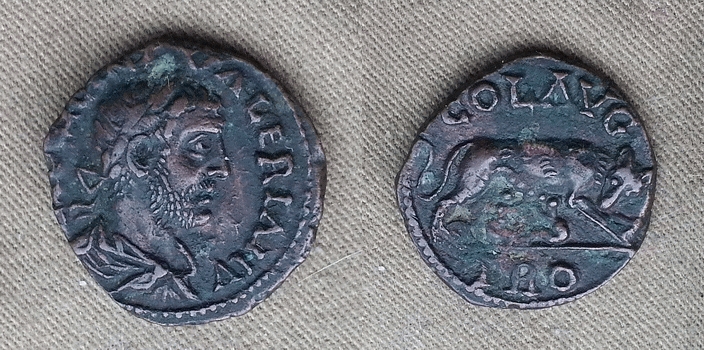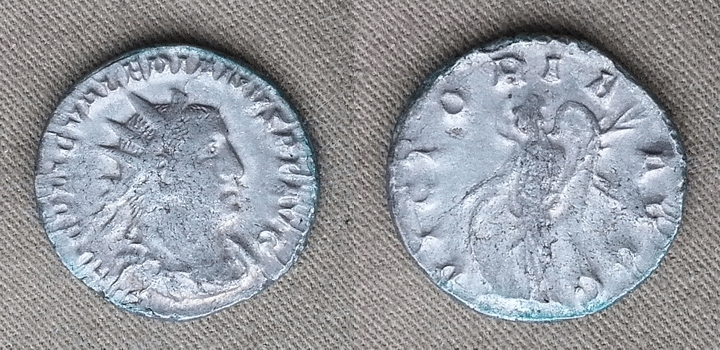
Valerian I AE 21mm of Alexandria Troas
Obverse: IMP LIC VALERIAN, Laureate, draped bust right
Reverse COL AVG-TRO, She-wolf standing right, suckling
twins
BMC 184, SNG Cop 200var.

Valerian Billon Antoninianus Rome mint, AD 256-257
Obv: IMP C P LIC VALERIANVS P F AVG, radiate, draped
and cuirassed bust right.
Rev: VICTORIA AVGG, Victory standing left holding
palm and resting hand on shield
RIC V-I 128C; RSC 224
|
|
Valerian (Latin: Publius Licinius Valerianus Augustus; 193/195/200 – 260
or 264), also known as Valerian the Elder, was Roman Emperor from 253 to
260 AD. He was taken captive by Sassanian Persian king Shapur I after
the Battle of Edessa, becoming the first Roman Emperor to be captured as
a prisoner of war, causing instability in the Empire.
Life
Origins and rise to power:
Unlike many of the ephemeral emperors and rebels who bid for Imperial Power
during the Crisis of the Third Century of the Roman Empire, Valerian was
of a noble and traditional senatorial family. Details of his early
life are elusive, but for his marriage to Egnatia Mariniana, who gave him
two sons: later emperor Publius Licinius Egnatius Gallienus and Valerianus
Minor.
He was Consul for the first time either before 238 CE as a Suffectus or
in 238 as an Ordinarius. In 238 he was princeps senatus, and Gordian
I negotiated through him for Senatorial acknowledgement for his claim as
emperor. In 251 CE, when Decius revived the censorship with legislative
and executive powers so extensive that it practically embraced the civil
authority of the emperor, Valerian was chosen censor by the Senate, though
he declined to accept the post. During the reign of Decius he was
left in charge of affairs in Rome when that prince left for his ill-fated
last campaign in Illyricum. Under Trebonianus Gallus he was appointed
dux of an army probably drawn from the garrisons of the German provinces
which seems to have been ultimately intended for use in a war against the
Persians. However, when Trebonianus Gallus had to deal with the rebellion
of Aemilianus in 253 CE it was to Valerian he turned for assistance in
crushing the attempted usurpation. Valerian headed south but was
too late: Gallus was killed by his own troops, who joined Aemilianus before
Valerian arrived. The Raetian soldiers then proclaimed Valerian emperor
and continued their march towards Rome. Upon his arrival in late
September, Aemilianus's legions defected, killing Aemilianus and proclaiming
Valerian emperor. In Rome, the Senate quickly acknowledged Valerian,
not only for fear of reprisals but also because he was one of their own.
Rule and fall:
A bas relief of Emperor Valerian standing at the background and held captive
by Shapur I found at Naqsh-e Rustam, Shiraz, Iran. The kneeling man
is probably Philip the Arab.
Valerian's first act as emperor on 22 October 253 was to make his son Gallienus
his Caesar and colleague. Early in his reign, affairs in Europe went
from bad to worse, and the whole West fell into disorder. In the
East, Antioch had fallen into the hands of a Sassanid vassal and Armenia
was occupied by Shapur I (Sapor). Valerian and Gallienus split the
problems of the empire between them, with the son taking the West, and
the father heading East to face the Persian threat.
In 254, 255, and 257, Valerian again became Consul Ordinarius. By
257, he had recovered Antioch and returned the province of Syria to Roman
control. The following year, the Goths ravaged Asia Minor.
In 259, Valerian moved on to Edessa, but an outbreak of plague killed a
critical number of legionaries, weakening the Roman position, and the town
was besieged by the Persians. At the beginning of 260, Valerian was
decisively defeated in the Battle of Edessa, and he arranged a meeting
with Shapur to negotiate a peace settlement. The truce was betrayed
by Shapur, who seized Valerian and held him prisoner for the remainder
of his life. Valerian's capture was a tremendous defeat for the Romans.
Persecution of Christians:
Valerian, while fighting the Persians, sent two letters to the Senate,
ordering steps to be taken against Christians. The first, sent in
257, commanded Christian clergy to perform sacrifices to the Roman gods
or face banishment. The second, the following year, ordered Christian
leaders to be executed, Roman senators and knights who were Christians
to perform acts of worship to the Roman gods or lose their titles, their
property and (if they continued to refuse), also to be executed.
It also decreed that Roman matrons who would not apostatize would lose
their property and be banished, and civil servants and members of the Imperial
household who would not worship the Roman gods would be reduced to slavery
and sent to work on the Imperial estates. This shows that Christians
were prevalent at this time in very high positions. Among the prominent
Christians executed as a result of their refusal to perform acts of worship
to the Roman gods as ordered by Valerian were Cyprian, bishop of Carthage,
and Pope Sixtus II, bishop of Rome, along with seven deacons including
Lawrence of Rome. When Valerian's son Gallienus became Emperor in
260, the legislation was rescinded.
Death in captivity:
Eutropius, writing between 364 and 378 CE, stated that Valerianus "was
overthrown by Shapur king of Persia, and being soon after made prisoner,
grew old in ignominious slavery among the Parthians." An early Christian
source, Lactantius, thought to be virulently anti-Persian, thanks to the
occasional persecution of Christians by some Sasanian monarchs, maintained
that for some time prior to his death Valerian was subjected to the greatest
insults by his captors, such as being used as a human footstool by Shapur
when mounting his horse. According to this version of events, after
a long period of such treatment Valerian offered Shapur a huge ransom for
his release. In reply, according to one version, Shapur was said
to have forced Valerian to swallow molten gold (the other version of his
death is almost the same but it says that Valerian was killed by being
flayed alive) and then had Valerian skinned and his skin stuffed with straw
and preserved as a trophy in the main Persian temple. It was further
alleged that it was only after a later Persian defeat against Rome that
his skin was given a cremation and burial. The captivity and death
of Valerian has been frequently debated by historians without any definitive
conclusion.
The Humiliation of Emperor Valerian by Shapur I, pen and ink, Hans Holbein
the Younger, ca. 1521
One modern scholar claims that, contrary to the account of Lactantius,
Shapur I sent Valerian and some of his army to the city of Bishapur or
Gundishapur where they lived in relatively good condition. Shapur
used the remaining soldiers in engineering and development plans.
Band-e Kaisar (Caesar's dam) is one of the remnants of Roman engineering
located near the ancient city of Susa. In all the stone carvings
on Naghshe-Rostam, in Iran, Valerian is represented holding hands with
Shapur I, a sign of submission.
It has been alleged that the account of Lactantius is coloured by his desire
to establish that persecutors of the Christians died fitting deaths; the
story was repeated then and later by authors in the Roman Near East fiercely
hostile to Persia.
The joint rule of Valerian and Gallienus was threatened several times by
usurpers. Nevertheless, Gallienus secured the throne until his own
assassination in 268 AD.
Family:
- Gallienus
- Publius Licinius Valerianus
Minor or Valerian the Younger was another son of Valerian I. Consul
in 265, he was probably killed by usurpers, some time between the capture
of his father in 260 and the assassination of his brother Gallienus in
268.
Information was taken from Wikipedia, the free encyclopedia
at this URL:
https://en.wikipedia.org/wiki/Valerian_(emperor)
|